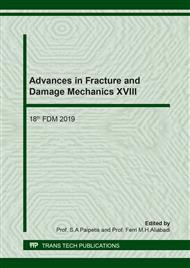p.13
p.19
p.25
p.31
p.37
p.43
p.49
p.55
p.61
Optimum Design of Damage Resistant Reinforced Composite Panels
Abstract:
In this work, an optimization procedure able to determine the optimum design of a stiffened aeronautical panel subjected to low velocity impacts is presented. As design variables, the number of plies and the stacking sequence of the panel have been considered. The optimization is based on a genetic algorithm, while the onset of the impact induced damage is predicted by means of an approach based on the critical impact force threshold. A multi-objective optimization has been carried out to determine, among the configurations able to withstand the low velocity impacts, the ones characterized by the maximum buckling load and the minimum weight.
Info:
Periodical:
Pages:
37-42
Citation:
Online since:
December 2019
Authors:
Keywords:
Price:
Сopyright:
© 2020 Trans Tech Publications Ltd. All Rights Reserved
Share:
Citation:


